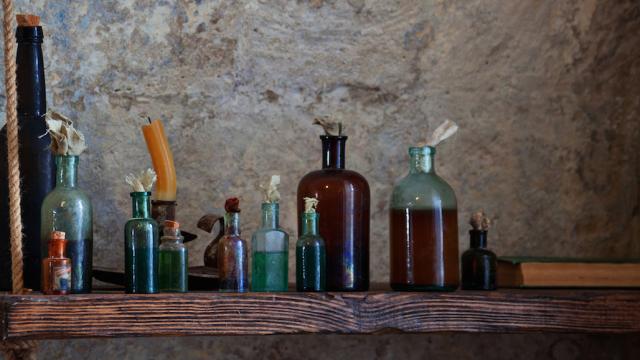My sister is a witch. Or, more precisely, a Wiccan astrologer and tarot reader. Growing up as a kid who worshipped Carl Sagan and Stephen Hawking, I found it hard to square her worldview with my own.
But that didn’t stop me from feeling a thrill when I visited her shabbily ornate, mist-clad Victorian house in San Francisco’s Mission District in the late 1990s. The city outside hummed with the techno-utopian dreams of the dotcom bubble, but inside candles burned, tarot cards shuffled, and books of occult lore beckoned from attic corners. It was in those candlelit rooms that I began to understand the appeal of the non-rational, and it changed my life.
When I began my graduate studies in history, I decided to focus on the period when magic and alchemy morphed into modern science. I was especially fascinated by John Dee, the wizardly court astrologer to Queen Elizabeth I. Although Dee believed he could speak to angels, he was also one of the leading mathematicians and geographers of his era. Robert Boyle and Isaac Newton followed in Dee’s footsteps, conducting empirical investigations of nature alongside studies of Biblical prophecy and alchemical secrets. John Maynard Keynes had it right when he observed in 1946 that Newton was not the first scientist — he was the last of the magicians. Newton’s generation especially loved to search for “occult virtues” — hidden phenomena latent in nature — and they found them in psychoactive drugs, along with a mystery that is still with us today.
I found my first hint of this Enlightenment obsession in the journals of Newton’s great rival, the quarrelsome but brilliant polymath Robert Hooke. On a fall day in 1689, Hooke ducked into a London coffee shop to buy a sample of cannabis from an East India Company merchant who’d become an aficionado of the plant. Hooke tested the drug’s effects on an anonymous subject and reported that it left the patient “unable to speak a Word of Sense.” Despite this, the verdict was good: the consumer was “not giddy, or drunk” and seemed “very merry,” laughing, dancing and performing “many odd Tricks.” Hooke reported to his fellow members of the Royal Society that cannabis was a valuable sleep aid, and could even “be of considerable Use for Lunaticks.” He predicted that London merchants might make a fortune selling it.
In other words, the same novel sensory effects that made substances such as tobacco, opium and cannabis desirable to global consumers also made them fascinating for the earliest experimental scientists. But what did those drugs mean — for them, and for us? How did our modern binary between “illicit drug” and “valuable medicine” come into being?
Drugs have had a bad reputation since at least the time of Shakespeare, whose sleazy, potion-dispensing apothecary in Romeo and Juliet enables that play’s tragic finale. Shakespeare tended to associate drugs with things such as witches (“mixture rank, of midnight weeds collected”) or Catholic assassins (“drug-damn’d Italy”). But in the 17th century, drugs acquired associations with the non-European world: the fever-ridden islands of the Caribbean, tropical Africa, or the exoticised “East Indies.”
Even the humble coffee bean (from Yemen and Ethiopia) and tea leaf (from China) were regarded as exotic medicines in this period. Dr Cornelis Bontekoe, a physician in the employ of the Dutch East India Company, recommended in his Tractaat (1679) that up to two hundredcups of tea a day were ideal for good health. Another doctor wrote of the Chinese that tea “frees them from all those evils that the immoderate use of wine doth breed in us.” But for Christian Europe, the medicinal virtues of foreign drugs such as coffee, tea, opium and cinchona (source of quinine) were counterbalanced by their origins in the lands of heathens.
The King of England himself joined a public chorus of voices attacking “Indies drugs” as unhealthy and un-Christian. King James’s A Counterblaste to Tobacco (1604) was a fantastically vitriolic diatribe against the “filthie custom” of smoking, blaming it for “infecting the air” at dinner tables throughout the realm — not to mention forcing smokers’ spouses into a “perpetual stinking torment.” James regarded smoking as a demonic custom from the shamanic cultures of the New World, evoking the “horrible Stigian smoke of the pit that is bottomless.” In other words: cigarettes smell like hell.
James wasn’t alone in demonising drugs. Inquisitors in Mexico City portrayed indigenous users of peyote as sorcerers, and Jesuit priests deep in the Amazon jungle sent back anxious reports about a plant called ayahuasca that allowed shamans to gather knowledge from evil spirits. Even the humble coffee bean provoked outraged diatribes about a “foreign liquor” that had “bewitched” consumers, causing enfeeblement, impotence, and worse.
Psychoactive drugs thus stood at the centre of debates about imperialism, religion, and globalisation, as well as science. They still do. It’s not a coincidence that drug cartels are among the most successful multinational enterprises of the 21st century — or that a global crusade against drugs, both prescription and illicit, is one of the core tenets of our era’s most successful new religion, the Church of Scientology.
It would not be a stretch to say that the wave of stimulants, intoxicants and narcotics that followed in the wake of Christopher Columbus helped to create modernity as we know it. From coffee, tea and chocolate to Adderall, painkillers and cocaine, and alternative remedies such as homeopathy and ginseng, consuming drugs stands at the centre of what it is to be a modern consumer.
This article has been excerpted with permission from Aeon Magazine. To read in its entirety, head here.
Aeon is a new digital magazine of ideas and culture, publishing an original essay every weekday. It sets out to invigorate conversations about worldviews, commissioning fine writers in a range of genres, including memoir, science and social reportage.
Picture: Oleksii Sagitov
